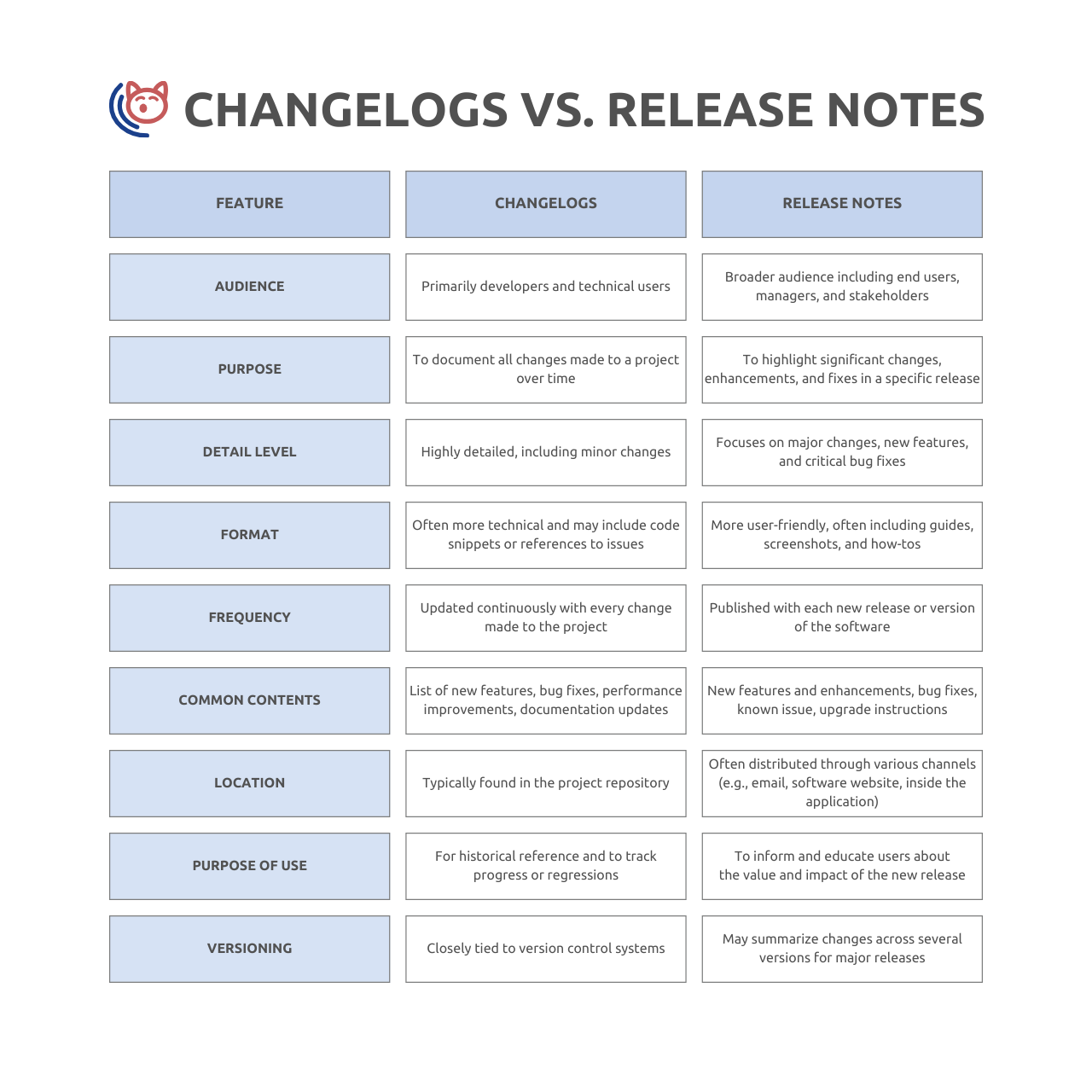Changelogs and release notes are two of the key ways you keep your users and clients up to date with the latest changes, newest features, and bug fixes during iterative releases of your app/service. Getting them right is important if you want to craft a good customer experience and keep your users/clients in the loop about the latest changes.
Sadly, however, many developers and managers mix up changelogs and release notes. Clearly understanding the differences between the two is key to creating both useful and readable changelogs and release notes. And in this blog post, we'll go over all their key differences and how they can inform your decisions when creating both changelogs and release notes.
Defining Concepts: What Are Changelogs and Release Notes?
Though changelogs and release notes are closely related, they are different concepts. By comparing their definitions, you can start to form an idea of their differences, which are key to writing good changelogs and release notes, especially for SaaS companies looking to communicate effectively with their development team and internal team or end-users.
- Changelog: A changelog is a document or record that provides a comprehensive list of changes, updates, and modifications made to a software product or system. It typically includes details about new features, bug fixes, improvements, enhancements, and any other notable changes that have occurred between different versions or releases of the product. The changelog is usually organized in chronological order. It serves as a reference guide for users, developers, and testers to enable them to understand what has been altered in the software. It gives a comprehensive overview of the app's development detailed history from the first release until the last one. Changelogs assist developers track technical changes.
- Release Note: Release notes are a summary or an overview of the changes and updates included in a specific version or release of a software product. Unlike changelogs, release notes are written for the end-user and are in a succinct format and written in non-technical language. They are intended for end-users or customers. They only provide a high-level description of new features, bug fixes, known issues, and other relevant information that users might need to be aware of when upgrading to the latest version, helping them understand the software changes without needing to dive into the technical details.
Changelog vs Release Notes: Key Differences
As you can tell by the definition, changelogs, and release notes are fundamentally different, and these differences show themselves in a variety of ways. In this section, we'll go over all the differences between the two in key aspects. Understanding these is essential to properly writing them during software development.

#1 Purpose
The purpose of a changelog is to have a comprehensive log of all changes made to a piece of software over its history. It not only lists the new features of the most recent version, but it also documents all changes made to the piece of software in detailed technical terms.
Release notes, on the other hand, are designed to be read by the typical user. That's why they're short, to the point, and use non-technical language. Release notes are keeping users informed about the latest changes, bug fixes, and existing issues in the new version of the software product.
#2 Audience
Changelogs are usually meant to be read by developers, technical users, managers, designers, shareholders, and other stakeholders in the company. Although some users do read them, they're not the primary audience, as they cater more to internal teams and those with a technical background.
Release notes, however, are designed with the end-users in mind. They are meant to be read by a general audience that has very little technical knowledge about the inner workings of the software itself.
#3 Content
The content of both is heavily influenced by the audiences they're written for.
The content of changelogs is largely technical. Each new feature is described in detail, its technical limitations are outlined, and its processes are enumerated. The bug fixes are described at length, and the existing technical issues that remain in the release are expanded on. In short, they are written for engineers and experts that want to get a detailed overview of the software, including all technical details and changes.
The content of release notes, however, is terse and simple. It includes information relevant to end users: the function of a new feature, the elimination of a vital bug, and simple future roadmaps for the company. It avoids going into detail on any of these, however: giving the users the bare essentials to understand what the update is about.
#4 Format
Changelog vs release notes formatting is a complicated topic because there are no universal formats for either release notes or changelogs. Companies in different industries usually follow different formats that better answer their needs.
Broadly, however, changelogs rely more on generic paragraphs to get their information across. They're more concerned about information density and completeness than readability, and this shows in the formatting.
For release note, however, the formatting can vary a lot. Although it is usually presented in plain language, simple bullet points, it can include pictures, videos, gifs, and even memes to get the information across. Readability and engagement here are key, and dense paragraphs don't lend themselves to either.
#5 Tone
The tone of a changelog is technical: it doesn't include any fluff, it cuts straight to the chase, and it doesn't bother with necessities and fluff. A changelog has a very specific purpose, and the tone reflects that. As it is usually not seen by end users, companies care far less about how they come across in a changelog.
For release note, however, the tone is very important. Companies usually want to come across as friendly, helpful, and engaged. The text is generally simple and includes fluff. They're written in a way the end user feels the company cares when they read it.
#6 Timing
Companies' policies around how many times changelogs are updated can substantially differ. But usually, changes are logged as soon as they're finalized. This helps the changelog remain complete with no missing details.
Release notes, however, are only released once with every update, and they include information solely about the changes introduced in that update.
Conclusion
By understanding the key differences between changelogs and release notes, you can write them both better. They are an important part of software development that you can't neglect. Changelogs help with internal bookkeeping and communication with key stakeholders while release notes help directly communicate and keep your core user base up to date.
If you have trouble designing and managing your release notes and changelogs, you can always rely on our tools here at Releasecat. They are designed to help you create and manage them efficiently.
How It Works
Click here to see an example of pop-up, designed to keep your app users informed about the latest updates.
Click here to see an example of a side panel that can be presented to users when they click the 'what's new' menu in your service.




